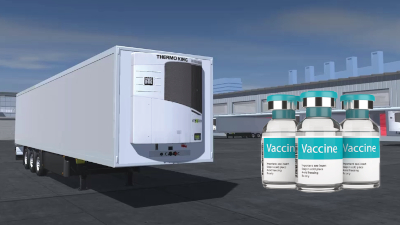Compartment Sanitation Procedure
This procedure outlines the main steps to be taken when sanitizing a compartment prior to the transportation of pharmaceutical or medicinal products. Compartment sanitation is required as part of Good Distribution Practice (GDP) and transporters are required to develop and implement procedures that specify their practices for cleaning and sanitizing equipment.
Notes
Note: Before undertaking any cleaning or sanitizing process, suitable protective clothing and protective equipment should be worn, the correct equipment should be used, and employees should be suitably trained.
Note: Only detergents and sanitation agents approved for use around pharmaceutical and medicinal products should be used. For example, detergents should be approved by the relevant National Health Authority, preferably biodegradable products that will make approved disposal of waste water easy.
Note: The use of sanitizers and detergents, including storage, handling, and Material Safety Data Sheets (MSDS) is outside the scope of this procedure.
Note: Local regulations regarding water run-off and water drainage may also need to be adhered to, so responsibility is with the transporter to check in advance.
Note: Certain additional sanitation procedures may be required by law for some pharmaceutical or medicinal products. Responsibility lies with the transporter to check in advance.
Sanitation Methodology
Step 1: Rough Cleaning
First remove all debris either by hand or use of brushes, brooms, scrapers, etc.
Collect and dispose of all debris appropriately.
A warm rinse is recommended to complete the rough cleaning.
Step 2: Wash Out with Detergent
After rough cleaning, apply an appropriate concentration of detergent to inside surfaces of compartment. Concentrations to use are in accordance with the manufacturer’s recommendations.
Scrub all surfaces manually or mechanically.
Make sure equipment used for cleaning and sanitizing is kept in clean and sanitary condition (e.g. hand-held hoses) to prevent cross contamination.
Apply detergents to all surface areas, including roof, walls, floor, bulkheads and doors.
Tip:
Water pressure at 6-8 bar (90 to 120 psi) and hot water at 80 degrees Celsius can significantly improve
wash out effectiveness.
Step 3: Rinsing
After cleaning and scrubbing with detergents, rinse all surface areas with hot potable water or steam. Use of a pressure washer is preferred.
After rinsing, check surfaces to ensure that all grease and debris has been removed. This should be done by physical touch.
Repeat above steps if necessary.
Step 4: Sanitizing
After rinsing, apply an approved sanitizer.
Use sanitizing agents as per manufacturer’s recommendations. This is especially important since some sanitizers require a final rinse and some do not.
Note:
Sanitizers are only effective on surfaces that have been thoroughly cleaned.
Step 5: Removal of Excess Water
Any areas where water has extensively pooled may serve as a medium for bacteria growth and should be dried.
Any fitted equipment that has the potential to rust should also be dried. All surfaces should be allowed to air dry.
If the compartment has a refrigeration unit with heating capability, this can be used to accelerate drying of all surfaces.
Sanitation Frequency
The following factors should be taken into account when establishing a sanitation schedule:
- Shipper should provide guidelines on sanitation standards to transporters, which will allow a suitable sanitation schedule to be established.
- Whenever you change the type of cargo that is being carried in the compartment you should perform a full sanitation to avoid cross-contamination.
- Another factor that should be considered when establishing a sanitation schedule is the production stage of the product being transported, e.g. APIs vs. finished product, open/closed containers, etc.
- At a minimum, a full compartment sanitation should be carried out at least once a month, and a compartment washout with detergent should be performed weekly.
Recording Requirements
Records should be kept of all sanitation activities to demonstrate compliance with GDP requirements. A typical sanitation record should contain the following information:
- Date and time
- Name of person who performed procedure
- Equipment ID (e.g. Trailer Number)
- Procedure followed
- Detergents, sanitizing agents, and equipment used
- Previously transported products
- Post-cleaning inspection and/or testing
- Any corrective actions taken
Best Practices
Establishing a regular sanitation schedule for compartments used to transport pharmaceutical or medicinal products is a recommended best practice.
Environmental testing to validate the effectiveness of sanitation procedures is a recommended best practice.
Verification of compartment sanitation by driver prior to loading is a recommended best practice.


